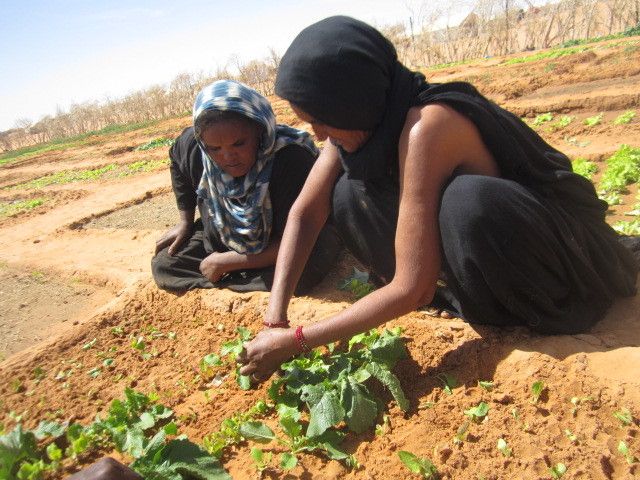
Lutheran World Relief
Ali agd Forach, a refugee from Mali, has learned how to make vegetables sprout from the sands of the Sahara desert.
Forach is one of 52,000 refugees who fled conflict in Mali and has been living in Mberra refugee camp, Mauritania, since 2012. “When I arrived there was nothing here,” Forach recalls. “From here to the horizon only hills of sand.”
Now, he is growing peanuts and watermelons. Forach is one of 5,000 people who have been taught new horticultural and irrigation techniques for farming in the Sahel in a farmer-to-farmer project funded by U.S. State Department’s Bureau of Population, Refugees, and Migration. The project is being carried out by Lutheran World Relief and its partner, the Lutheran World Federation.
“It was quite difficult to convince people that they could grow vegetables here,” recalls project coordinator Papa Diallo. During the day, the temperature climbs to 50 degrees Celsius. Hot winds, frequent sandstorms and sudden heavy rain can destroy many months work within minutes.

Lutheran World Relief
The Malian Refugee & Host Communities’ Livelihoods project (MARCOL) has a curriculum that includes preparing nurseries, seedling production, organic fertilization, cultivation and techniques such as drip-to-drip-irrigation that make the most of the meager water reserves in the Sahel.
The project targets 5,000 people from the camp and the host community. This includes 4,134 women, reflecting the traditional division of labor and the population in the camp. A select 200 of them received special gardening training. Each of those 200 people are sharing what they learned in groups of 25 people.
Where there was sand before, plots measuring altogether 31 hectares have sprung up in the camp and surrounding villages. “We now have more vegetables available, and since more people are selling them, the price in the market has dropped,” Tassayate ub Med says. Her family’s situation has improved a great deal. Previously, they spent about $3 for a meal; now it’s only $1.
Living in Mberra represents a big change to the refugees. Walking long distances to work the fields in the heat and carrying heavy water cans is difficult for the women. Back in Mali, many were nomadic pastoralists. Some brought their cattle and goats with them when they fled. But in Mberra, hardly enough water and grazing grounds exist for the local host community.
Teaching gardening techniques has minimized conflicts with the host community, and the addition of vegetables has improved the nutritional value of the refugees’ traditional diet. Nevertheless, many Malian refugees are still reluctant to exchange their traditional diet of milk and meat for watermelons, peanuts and eggplants. Some sell their vegetables to buy meat.
But Forach says he hopes to continue using the techniques he’s learned when he is able to return to his homeland.
“I plan to rebuild my life in Mali,” he says. “I will bring what I have learned here and share it with others if I can. I am a farmer. I don’t want to do anything else.”

Lutheran World Relief
